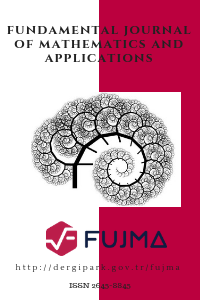Error Elimination From Bloom Filters in Computer Networks Represented by Graphs
Error Elimination From Bloom Filters in Computer Networks Represented by Graphs
Computer network, Edge labelling, Shortest path Undirected graph,
___
- [1] M. X. Punithan, S. Seo, King’s graph-based neighbor-vehicle mapping framework, IEEE trans Intell Transp Syst, 14 (2013), 1313–1330.
- [2] O. Favaron, G. H. Fricke, D. Pritikin, J. Puech, Irredundance and domination in kings graphs, Discrete Math. Elsevier, 262 (2003), 131–147 .
- [3] E. J. Ionascu, D. Pritikin, S. E. Wright, k-Dependence and domination in kings graphs, Amer. Math. Monthly, 115 (2008), 820–836.
- [4] R. Dantas, F. Havet, R. M. Sampaio, Minimum density of identifying codes of king grids, Discrete Math., 341 (2018), 2708–2719.
- [5] G. C. Kayaturan, Representing Shortest Paths in Graphs Using Bloom Filters without False Positives and Applications to Routing in Computer Networks, Ph.D thesis, Univeristy of Essex, UK, 2018.
- [6] B. H. Bloom, Space/time trade-offs in hash coding with allowable errors, Commun. ACM, 13 (1970), 422–426.
- [7] Y. Lu, B. Prabhakar, F. Bonomi, Perfect hashing for network applications, IEEE Int. Symp. Inf. Theory - Proc., (2006), 2774–2778.
- [8] C. E. Rothenberg, C. Macapuna, B. Alberto, M. F. Magalh˜aes, F. L. Verdi, A. Wiesmaier, In-packet Bloom filters: Design and networking applications, Comput. Netw., Elsevier, 55 (2011), 1364–1378.
- [9] X. Yang, A. Vernitski, L. Carrea, An approximate dynamic programming approach for improving accuracy of lossy data compression by Bloom filters, Eur. J. Oper. Res. 252 (2016), 985–994.
- [10] A. Saha, N. Sengupta, M. Ramanath, Reachability in large graphs using bloom filters, Proceedings - 2019 IEEE Trans Knowl Data Eng, ICDEW 2019, (2019), 217–224.
- [11] M. Mitzenmacher, Compressed bloom filters, IEEE ACM Trans Netw., 10 (2002), 604–612.
- [12] A. Broder, M. Mitzenmacher, Network applications of bloom filters: A survey, Internet Math., Taylor & Francis , 1 (2004), 485–509.
- [13] L. Carrea, A. Vernitski, M. Reed, Optimized hash for network path encoding with minimized false positives, Comput. Netw., 58 (2014), 180–191.
- [14] G. C. Kayaturan, A. Vernitski, A Way of eliminating errors when using Bloom filters for routing in computer networks, Comput. Electr. Eng. (CEEC), 2016 8th, (2016), 95–100.
- [15] G. C. Kayaturan, A. Vernitski, Routing in hexagonal computer networks: How to present paths by Bloom filters without false positives, Netw., ICN2016. , (2016), 52–57.
- [16] G. C. Kayaturan, A. Vernitski, Encoding shortest paths in triangular grids for delivery without errors, Proceedings - ICFNDS, (2017), 7.
- [17] S. Tarkoma, C. E. Rothenberg, E. Lagerspetz, Theory and practice of bloom filters for distributed systems, IEEE Commun. Surv. Tutor., 14, (2012), 131–155.
- ISSN: 2645-8845
- Yayın Aralığı: Yılda 4 Sayı
- Başlangıç: 2018
- Yayıncı: Fuat USTA
Mustafa ÖZKAN, Berk YENİCE, Ayşe Tuğba GÜROĞLU
Approximately Near Rings in Proximal Relator Spaces
Ebubekir İNAN, Ayşegül KOCAMAZ
Some Results on the $p$-Weak Approximation Property in Banach Spaces
Ayşegül KETEN ÇOPUR, Adalet SATAR
Mahpeyker ÖZTÜRK, Abdurrahman BÜYÜKKAYA
Characterization of Intuitionistic Fuzzy Collineations in Intuitionistic Fuzzy Projective Planes
Error Elimination From Bloom Filters in Computer Networks Represented by Graphs
